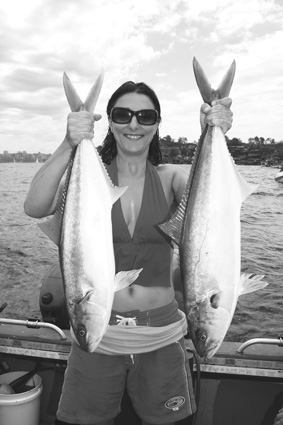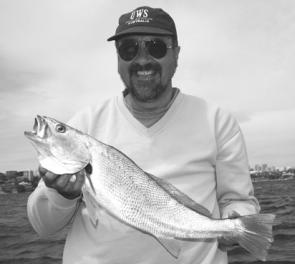Its not over yet. This time last year marked some of the best kingie fishing of the season and we have even caught them as late as June.
In fact this can be a great time for mixed bags as the Summer fish linger and the first of the Winter fish move in. I suggest using a variety of techniques and baits to cover all options.
Don’t forget that the Jewies in the upper reaches are at their best now and probably your best shot at one on lures. Flattie spinning around the moorings in the lower reaches will be firing now as the flatties go nuts, feeding up for their Winter hibernation
One of the Winter fish that will be at their peak over the next few months is the john dory. Their distribution extends around the southern half of Australia but the main concentrations are in southern NSW. They are, however, found as far north as Bundaberg in Queensland. During Summer they live out on the deep reefs and according to divers I’ve spoken to are also common around wrecks, particularly those on a sand bottom. They move into the bays and harbours in May and retreat back to the offshore reefs in about September. However, early season from May to July offers the best fishing.
Dories tend to favour the deep, clear bays and harbours and are rarely taken in shallow or muddy rivers or estuaries.
Live baits are obviously the only way to go. Small reef-type fish are the ultimate but small yakkas or slimies will do. If you are forced to use yakkas or slimies make sure you slow them down to ‘dory speed’ by trimming their tails by cutting the fin section of the tail with your line snips or pliers. Don't cut the tail itself because this will eventually kill the bait.
Dories live close to the bottom and are slow-moving, which is what makes reef fish a much better bait – it’s their natural food. You certainly won't see them in hot pursuit of a school of slimies or yakkas.
You don't need heavy gear to fish for dory. Having said that, I would still recommend at least 6kg or 10 kg. Given that you are not going to get a fight out of them with heavy line or light, I strongly suggest using heavier line due to the very real possibility of picking up a much larger fish like a kingie or jewfish on your live bait.
Fish straight down below the boat. To set your depth, drop your rig to the bottom without the bait. When you feel the sinker hit the bottom, lift it up about two metres and set your rod in the holder. Now pull the line up by hand, pin the bait and send it back to the bottom. This way you will know exactly what depth it is at – two metres up. If you try to set it with the live bait on the hook you will never know exactly how deep you are due to the fact that the bait is always towing the sinker.
The rig is simple, consisting of a 40g bean sinker on the main line terminated with a swivel. That is then tied to a nylon trace of about 10kg, finished off with a 4/0 to 6/0 light-gauge, octopus-style, chemically-sharpened hook.
The most effective method from the jetties or shore seems to be suspending the above mentioned rig 3m to 6m (depending on water depth) under a bobby cork with the use of a running stopper.
Right on high tide and the first hour of the run out is prime dory time, especially if this occurs early morning or late afternoon, although it is possible to pick up the odd one right through the day.
Use plenty of berley when dory fishing. Although the berley doesn't directly attract the dory, it attracts clouds of baitfish which are of great interest to the dory.
Dory on lures are a very real possibility. I have heard of at least one taken on fly and in New Zealand they are regularly sight-fished off the jetties using big soft plastic shad tails on lead jig heads. Because dory are regularly sighted lurking around the jetties over here, there's no reason we couldn't do the same thing.
Reads: 5535
John dory are welcome Winter visitors not for their sporting prowess but for their delicious white flesh.

Don’t fish too light for dory because lingering kings are fond of the same live baits.

The jewfish is another candidate that relishes live baits meant for john dory.




